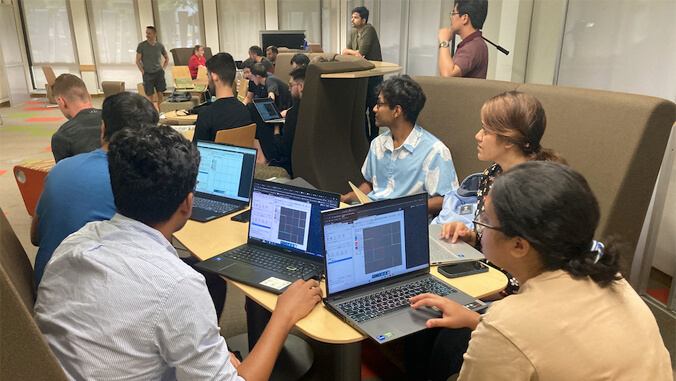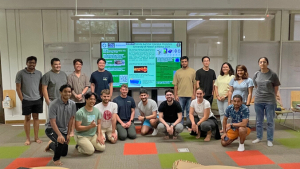
Nearly 20 University of Hawaiʻi at Mānoa graduate students across several disciplines participated in a one-week intensive training program on computational modeling to solve complex problems related to Earth and energy. The workshop, hosted at UH Mānoa, is supported by a $5 million grant through the U.S. Department of Energy’s Earthshots Initiative to advance clean energy technologies within the next decade.
The participants learned theoretical and computational skills to model and understand geothermal energy and how partial differential equations are used to model complex physical processes and solved numerically. One of the codes the students learned about is PISALE, which was developed by UH researchers in collaboration with the U.S. Department of Energy (DOE) labs and other universities.

“Key to this workshop was the breadth of research interests represented by the students, from atmospheric sciences to engineering, physics, computer sciences and mathematics,” said UH Mānoa Department of Mathematics Professor Monique Chyba. “Each discipline comes with its own particular challenges and opportunities, but the extent to which the software described in this workshop can adapt to each situation is remarkable. Training the next generation of scientists that will go on working on the world climate issue as well as the health crisis is a primary mission of each university. These graduate students are our future.”
Chyba organized and led the workshop, and was assisted by computational scientists from two of the DOE labs, Lawrence Berkeley National Laboratory (LBNL) and Lawrence Livermore National Laboratory. Due to its geographic location, students at UH are often isolated from opportunities like this compared with students in the continental U.S.
Hands-on problem solving, visualization, computational experience

The scientists conducted hands-on problem solving sessions where the students ran software on specific problems using Koa, UH’s high performance computing cluster, as well as Amazon Web Services and the Perlmutter supercomputer, run by DOE’s National Energy Research Scientific Computing Center.
“We were excited to be able to share our knowledge with these students,” said Ann Almgren, a senior scientist at LBNL. “Having these in-person interactions where we are able to talk about the types of projects we work on and how we solve these problems is really satisfying. It’s also wonderful for us to hear from the students about what they’re working on and how enthusiastic they are to tackle the next generation of challenges.”
Exposing the students to Earthshot applications was a priority. The workshop focused on geothermal energy (heat, water and permeability can support cost-competitive rates of energy extraction), and wind energy. Experts from Nā Pua Makani, a wind energy project in Kahuku, presented on the wind farm, followed by an open discussion on the use and capabilities of wind turbines. The students also visited UH’s Applied Research Laboratory and LAVA lab.
“I am now eager to learn about the particles, geothermal, these terms are really new,” said Azibun Nuder, a master’s student in computer science. “I will think about the opportunities to collaborate because now I have the idea how to collaborate, how to do computational theories and everything. That was a new perspective for my research.”
Paving the way for future energy solutions
The summer program is supported by a UH Mānoa project, “Ka mana o ka lā: Modeling our energy future,” that will address fundamental applied mathematics and computer science issues relevant to advanced high-performance computational modeling for Energy Earthshots.
The principal investigator of this project is Alice Koniges, graduate faculty in the UH Mānoa Department of Information and Computer Sciences. The project is one of 29 across the country that received a total of $264 million from the Department of Energy. All projects will help to develop solutions for the scientific challenges outlined by the DOE’s Energy Earthshots Initiative to advance clean energy technologies within the decade.
“The workshop, as part of our important Science Foundations for Energy Earthshot award, is fundamental to educating the UH community and students, while also serving as a conduit for Hawaiʻi to understand and participate in clean energy options,” Koniges said. “The workshop format is particularly conducive to providing educational opportunities locally and for mainland participants to understand Hawaiian values.”
—By Marc Arakaki

